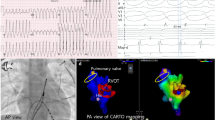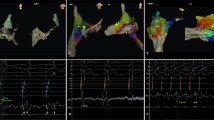Abstract
Introduction
Definitive therapy of idiopathic right ventricular arrhythmias (VA) remains a challenge in interventional electrophysiology. The aim of this study was to evaluate the utility of EnSite Velocity system in the catheter ablation of RV tachycardia in children.
Methods
Thirty-five children with idiopathic right VA underwent catheter ablation procedure using the EnSite Velocity system guidance.
Results
The mean patient age was 12.0 ± 3.7 years and the mean patient weight was 43.6 ± 18.7 kg. The origin of right VA was divided into right ventricular outflow tract (RVOT) (30 patients) and other right ventricular localizations (five patients). The mean procedure and fluoroscopy times were 175 ± 67 min and 2.35 ± 1.89 min, respectively. No fluoroscopy was used in 19 patients. Acute success was achieved in 29 patients (83 %). The focus of VA was epicardial in three failed procedures. Cryocatheter (6-mm or 8-mm tip) was used in six patients, radiofrequency ablation (RFA) (4-mm or 8-mm tip) in 26 patients, and 4-mm tip irrigated RFA in three patients. During a mean follow-up of 15.9 ± 7.1 months, ventricular tachycardia recurred in six patients (20 %). There were three complications (transient atrioventricular block developed in one patient during parahissian cryoablation and two patients developed transient complete right bundle branch block).
Conclusions
Catheter ablation of idiopathic right VA in children can be performed safely and effectively with limited fluoroscopy using the EnSite Velocity system.

Similar content being viewed by others
References
Pfammater JP, Paul T. Idiopathic ventricular tachycardia in infancy and childhood: a multicenter study on clinical profile and outcome: working group on dysrhythmias and electrophysiology of the Association for European Pediatric Cardiology. J Am Coll Cardiol. 1999;33:2067–72.
Iwai S, Cantillon DJ, Kim RJ, et al. Right and left ventricular outflow tract tachycardias: evidence for a common electrophysiologic mechanism. J Cardiovasc Electrophysiol. 2006;17:1052–8.
Smeets JLRM, Rodrigues LM, Tımmermans C, Wellens HJJ. Radiofrequency catheter ablation of idiopathic ventricular tachycardias in children. PACE. 1997;20:2068–71.
Schneider HE, Kriebel T, Jung K, Gravenhorst VD, Paul T. Catheter ablation of idiopathic left and right ventricular tachycardias in the pediatric population using noncontact mapping. Heart Rhythm. 2010;7:731–9.
Baksiene D, Sileikiene R, Sileikis V, et al. Idiopathic ventricular tachycardia in children: curative therapy with radiofrequency ablation. Med (Kaunas). 2007;43(10).
Miszcak-Knecht M, Szumowski L, Posadowska M, et al. Idiopathic ventricular arrhythmia in children and adolescents: early effectiveness of radiofrequency current ablation. Kardiol Pol. 2014;72:1148–55.
Ozyilmaz I, Ergul Y, Akdeniz C, Tanidir IC, Tuzcu V. Catheter ablation of idiopathic ventricular tachycardia in children using the EnSite NavX system with/without fluoroscopy. Cardiol Young. 2014;24:886–92.
Wang S, Zhu W, Hamilton RM, Kirsh JA, Stephenson EA, Gross GJ. Diagnosis-specific characteristics of ventricular tachycardia in children with structurally normal hearts. Heart Rhythm. 2010;7:1725–31.
Grimm W, Marchlinski FE. Accelerated idioventricular rhythm: bidirectional ventricular tachycardia. In: Zipes DPJ, editor. Cardiac electrophysiology: from cell to bedside. Philadelphia, PA: Saunders; 2004. p. 700–4.
Daniels DV, Lu YY, Morton JB, et al. Idiopathic epicardial left ventricular tachycardia originating remote from the sinus of Valsalva: electrophysiological characteristics, catheter ablation, and identification from the 12-lead electrocardiogram. Circulation. 2006;113:1659–66.
Iwamoto M, Niimura I, Shibata T, Yasui K, Takigiku K, Nishizawa T. Long-term course and clinical characteristics of ventricular tachycardia detected in children by school-based heart disease screening. Circ J. 2005;69:273–6.
Morwood JG, Triedman JK, Berul CI, et al. Radiofrequency catheter ablation of ventricular tachycardia in children and young adults with congenital heart disease. Heart Rhythm. 2004;301–8.
Von Bergen NH, Bansal S, Gingerich J, Law IH. Nonfluoroscopic and radiation-limited ablation of ventricular arrhythmias in children and young adults: a case series. Pediatr Cardiol. 2011;32:743–7.
Junji Fukuhara MD, Naokata Sumitomo. Electrophysiological characteristics of idiopathic ventricular tachycardia in children. Circ J:(75).
Friedman PA, Asirvatham SJ, Grice S, et al. Non-contact mapping to guide ablation of right ventricular outflow tachycardia. J Am Coll Cardiol. 2002;39:1808–12.
Ribbing M, Wasmer K, Monnig G, et al. Endocardial mapping of right ventricular outflow tract tachycardia using noncontact activation mapping. J Cardiovasc Electrophysiol. 2003;14:602–8.
Soejima Y, Aonuma K, Iesaka Y, Isobe M. Ventricular unipolar potential in radiofrequency catheter ablation of idiopathic Non-reentrant ventricular outflow tachycardia. Jpn Heart J. 2004;45:749–60.
Tanaka Y, Tada H, Ito S, et al. Gender and age differences in candidates for radiofrequency catheter ablation of idiopathic ventricular arrhythmias. Circ J. 2011;75:1585–91.
Tung R, Michowitz Y, Yu R. Epicardial ablation of VT: an institutional experience of safety and efficacy. Heart Rhythm. 2013;10:490–8.
Brugada J, Blom N, Sarquella-Brugada G, et al. Pharmacological and non-pharmacological therapy for arrhythmias in the pediatric population: EHRA and AEPC-arrhythmia working group joint consensus statement. Europace. 2013;1:1337–82.
Author information
Authors and Affiliations
Corresponding author
Ethics declarations
All patients and/or their legal guardians gave verbal and written consent for the procedure.
Conflict of interest
The manuscript, as submitted or its essence in another version, is not under consideration for publication elsewhere, and will not be published elsewhere while under consideration by Journal of Interventional Cardiac Electrophysiology. The authors have no commercial associations or sources of support that might pose a conflict of interest. All authors have made substantive contributions to the study, and all authors endorse the data and conclusions.
Rights and permissions
About this article
Cite this article
Akdeniz, C., Gul, E.E., Celik, N. et al. Catheter ablation of idiopathic right ventricular arrhythmias in children with limited fluoroscopy. J Interv Card Electrophysiol 46, 355–360 (2016). https://doi.org/10.1007/s10840-016-0133-6
Received:
Accepted:
Published:
Issue Date:
DOI: https://doi.org/10.1007/s10840-016-0133-6




